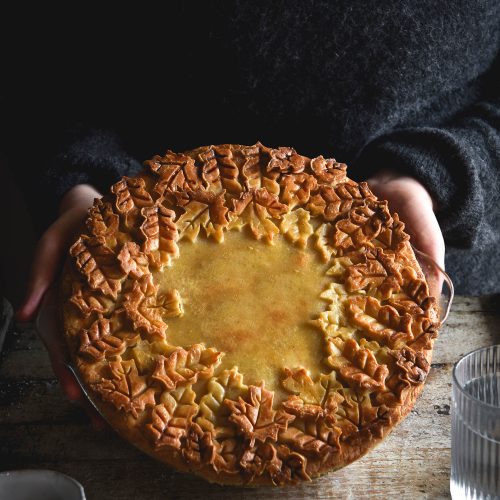
Gluten free pumpkin, sage and goat's cheese tart
Nut free, FODMAP friendly, gum free, starch free option
Equipment
- 1 x 25cm (10 inch) pie dish
Ingredients
For the roast vegetables:
- Green part of 2 leeks finely chopped
- 1 bunch sage (20g)
- 1 kg Japanese or Kent pumpkin cut into cubes
- 2-3 tablespoons olive oil
- 1/2 teaspoon ground nutmeg
- 1 teaspoon dried thyme or another dried herb, optional
- 1/2 teaspoon salt and some freshly cracked pepper
For the pastry:
- 160 g (1 cup) fine white rice flour
- 60 g (1/2 cup) tapioca flour (see notes)
- 1 teaspoon fine salt
- 2 teaspoons psyllium husk powder or 1 tablespoon psyllium husks (see notes)
- 125 g butter cold and cubed
- 75 g full fat Greek or plain lactose free yoghurt see notes
- Ice water to bring the dough together I needed
To finish:
- 4 extra large eggs
- 100 g full fat Greek or plain lactose free yoghurt
- 1/2 teaspoon salt and freshly cracked pepper
- 50 g finely grated parmesan optional
- 150-200 g goats cheese or feta
Instructions
To roast the vegetables:
- Preheat the oven to 180C/356F. Place the leeks and sage on a large baking tray and top it with the pumpkin. Drizzle over the oil then season with the nutmeg, thyme, salt and pepper. Use your hands to gently ensure everything is coated. Place in the oven for 30-45 minutes or until the pumpkin is just soft. If the leeks or sage begin to burn, take them out early and set them aside.
To make the pastry:
- Combine the flours, salt and psyllium husk in a large mixing bowl. Add the cold cubes of butter, and use your fingers to rub the butter into the flour until only small bits remain. It should resemble a course meal.
- Stir in the yoghurt, then get your hands in and distribute it evenly. Add the water – just enough to form a smooth dough with no dry bits on the bottom of the bowl. Use the least possible amount of water to achieve this – drier pastry equals crispy, flaky pastry. Bring the dough together into a ball.
- Lightly flour a sheet of baking paper with tapioca flour. Roll the dough out into a large rectangle – about 35cm x 30cm to be wider than the pie dish lip. Patch up any cracks as they appear. The dough should be about 1/2 centimetre thick.
- Place your pie dish, upside down in the centre of the dough. Slide one hand under the baking paper and into the centre of the dish. Use the other hand to hold the dish base. Flip the dish over and let the pastry fall into it. Be generous in letting the hanging parts of pastry fall into the dish or it will break.
- Patch up any cracks and press the pastry firm up against the sides of the dish. Trim the overhanging edges with scissors and neaten them up or crimp them as you see fit. Use a fork to poke some air holes in the pie base and pop it in the fridge to chill.
To finish:
- Allow the roasted vegetables time to cool before assembling the tart. Whisk the eggs with the yoghurt, seasoning and parmesan if you're using it.
- Arrange the vegetables in the pie dish. I like to put the leeks on the bottom so they don't burn, and finish with the pumpkin pieces. Once the tart is half full, add half the egg mixture and half the goat's cheese or feta. Repeat with the remaining ingredients. Gently press the filling down to distribute it evenly in the dish.
- Place the pie in the oven with a large piece of foil sitting over the top but not touching the pie or preventing air flow. This will stop the pastry and filling from getting too brown as the pie bakes. Bake for 40 minutes, then remove the foil and cook for an additional 20 minutes.
Notes
- You can make a starch free pie crust as per the instructions in the body of the post
- The pastry is particularly fragile without starch, so make sure you read the notes carefully.
- If you want to make a starch free crust, you will need to use extra psyllium husk for binding. I would recommend 3-4 teaspoons of psyllium husk powder or 2 tablespoons psyllium husk. Even if the crust falls apart as you're rolling it, you should still be able to patch it into your pie dish.
- Monash have recently (as of November 2024) lowered the threshold for Japanese/Kent pumpkin. It is low FODMAP in 75g serves and up to 161g serves per person. In 162g serves, it contains moderate amounts of fructans. It is still the pumpkin variety that you can eat most of on the low FODMAP diet. Another thing to keep in mind is that you don't need to change anything if you have been eating pumpkin without issue prior to this change.
- If you do react to pumpkin, 1 slice of pie contains approximately 125g pumpkin which is still under the low FODMAP threshold.
Tried this recipe?Let us know how it was!